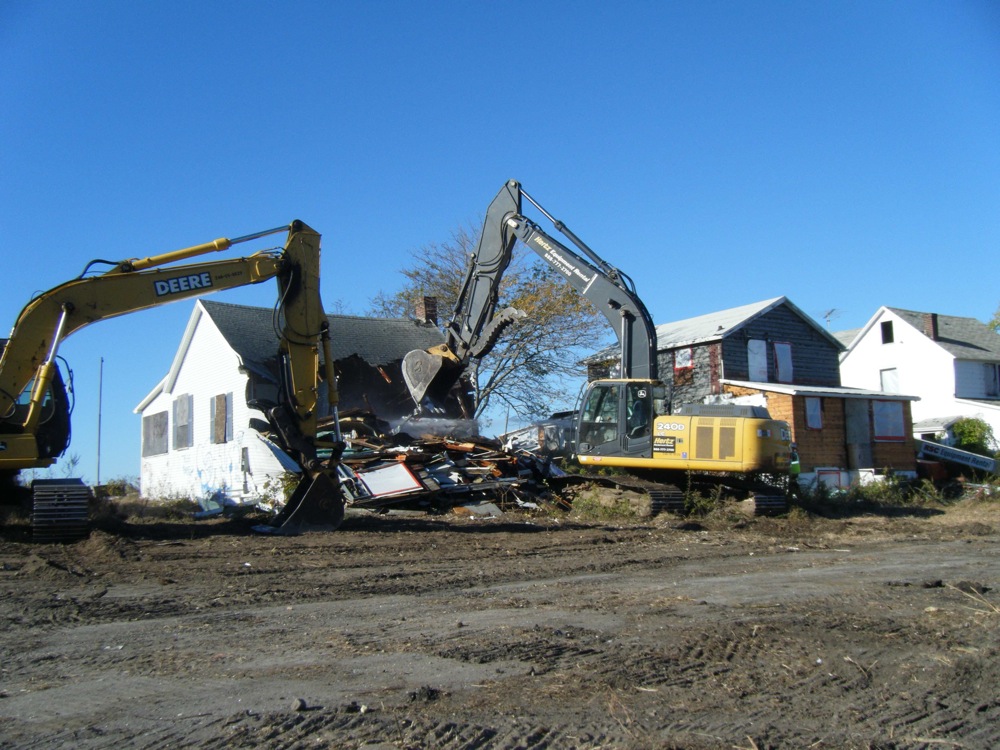Cottage No. 31 goes down, Long Beach West, Stratford, Connecticut, Oct. 22, 2010
The Connecticut Mirror

It’s not often that civilization is demolished to make way for wild birds, especially within sight of Connecticut’s largest city. That’s what’s happening on a long barrier beach between Bridgeport and Stratford.
On the Stratford side, a yellow excavator crashed its bucket into the roof of cottage number 31 of Long Beach West last week. Timed to avoid most of the rare shore birds’ nesting seasons, the excavator turned the abandoned beach house into a debris pile within about 10 minutes.
By Thanksgiving, the original 37 cottages and 27 outbuildings will all be gone. This is perhaps one of the odder projects funded by federal stimulus money, but various people in the many groups, both private and government, that worked for this were practically cheering as number 31’s roof crumpled.
“Tearing down the cottages will have a lot of benefit, not just for the wildlife but for the public,” said Patrick Comins, director of bird conservation for Audubon Connecticut.
“For the wildlife, the houses in the condition they’re in, are sheltering predators—feral cats, raccoons. They’re taking some of the upland dune habitat,” Comins went on. “For people, there’s been no safe access.”
Fourteen years ago, a fire closed the only bridge out to the beach. Bridgeport’s side, once home to the famous Pleasure Beach amusement park, was still a popular summer destination. At the time, the city had just completed a $2 million bathhouse; the public never got to use it.
Stratford’s side of the beach held cottages leased to summer residents who now had to swim, boat, or walk out to them. One by one, the town let those leases expire. Wild animals found shelter in the cottages; vandals looted, squatted in, and sometimes set fire to them.
Over the years, residents and officials of both towns tried to figure out what to do with valuable waterfront property in one of the most densely populated parts of the state. In the end, the two communities came to different conclusions.
A wildlife refuge?
Just a year ago, it looked as if both municipalities were ready to sell their beaches to the U.S. Fish and Wildlife Service to add to the waving marshes of the nearby Stewart B. McKinney refuge.
Stratford voters even approved a $10 million sale in 2009. But by then the appraised value had plummeted along with the economy, and the deal, by its terms, was off.
That was good news for opponents of the sale, like Stratford resident Morgan Kaolian, a pilot and Bridgeport native who grew up going to Pleasure Beach. He spent thousands of his own dollars against the referendum to sell the beach, arguing the town should keep it for residents’ use.
But despite the demise of the sale agreement, the Fish and Wildlife Service maintained an interest in the Stratford beach. It’s Southern New England regional coastal program received almost $1 million in funds from the American Recovery and Reinvestment Act to tear down the old cottages and restore the beach to its natural state.
The deal will extend Stratford’s municipal beach to the border with Bridgeport. Although the area will be open to the public, the town’s agreement with the Fish and Wildlife Service says it can’t be developed or Stratford will have to repay the demolition and restoration money.
While he’s relieved that the town is keeping it, Kaolian still objects to the town’s deal with the U.S. Fish & Wildlife Service. First, he wants the town to keep the temporary road demolition trucks are using to reach the cottages. It is a long walk from the Long Beach West parking lot out to the rest of the beach. “Once they return it to the natural state, which is sand, no one will be able to walk on it who is of any age or has physical impairments,” he said.
“I had also asked to keep a couple of cottages,” Kaolian said. “They should have kept a few of them to keep a footprint so they could build a comfort station, a nature center, a lifeguard station, and even if they thought ahead enough to put someone out there 24/7” as a warden.
Of the stimulus money for cottage demolition, he said: “It’s a grant. It’s money for the people. They’re spending it as money for the wildlife.”
Bridgeport opts for a park
Bridgeport, too, earlier had talked with the U.S. Fish and Wildlife Service about selling, but ultimately decided that it wanted to leave open the possibility of ball fields and a bathhouse on its part of the beach, according to Ted Grabarz, director of sustainability and deputy director of public facilities for Bridgeport.
Meanwhile, on its own, the city of Bridgeport secured $1.3 million in stimulus funds of its own to begin running a water-taxi from the mainland out to the beach. A Connecticut Department of Environmental Protection grant of $150,000 will fund architectural plans for a new city park.
“We want to restore the ability to have a recreation spot for people of Bridgeport,” Grabarz said in an interview. He said that there are now no parks accessible to the people of Bridgeport’s East Side and East End neighborhoods, who live closest to Pleasure Beach and the burned-out bridge.
Memories of Pleasure Beach are strong among Bridgeport residents and former residents like Kaolian. He runs a corporation, Long Island Sound America, which held fairs and nature events on the Pleasure Beach side until the mid-1980s. He and another Bridgeport native, Tim English, maintain a website, www.savepleasurebeach.com, that posts photos, a timeline, and opinions. For example, the two criticize the city’s decision last summer to tear down some of the old amusement park structures.
The old amusement park isn’t coming back, but Grabarz said the city does plan some development on its end of the beach. The city is interviewing landscape firms for a master plan, he said. Another proposal is out for an architect to refurbish the vintage-1990s buildings: a bathhouse and restaurant and welcome center. He said they aim for both “passive and active” recreation. “Passive in the sense of protecting a lot of the biological resources out there which would include the piping plover, but potentially doing some ball fields out there as well, as well as ways we could gain some revenue out there, like a sailing club.”
“We’re hoping that by next spring-summer, we might be able at least to get some people out there,” Grabarz said. “Clean it up and get people out there, assuming we get this water taxi in place.”
Comins of Audubon Connecticut said that there is enough room for people and wildlife to meet their needs out here on the barrier beach. Comins has surveyed birds here for many years. He has watched as the birds like American oystercatchers, a state species of special concern, and two state-threatened species, piping plovers and least terns, returned to nest here in greater numbers after the people left.
Many groups worked to make the beach more habitable for birds. These included the U.S. Fish & Wildlife Service, the Connecticut Department of Environmental Protection, the National Audubon Society, the Trust for Public Land, Ducks Unlimited, and others.
Regardless of the municipalities’ plans, the Fish and Wildlife Service still would like to own the land someday. Rick Potvin, of the Connecticut office of the U.S. Fish and Wildlife Service, said the barrier beach is land the service would someday like to own, but no sale offer is active now.
And a sale doesn’t seem likely, at least for the foreseeable future. Mayor John A. Harkins says Stratford’s side is staying in municipal hands. “Stratford is not selling Long Beach West and will retain ownership,” he said in an email interview, adding, “There is no plan with Bridgeport regarding use.”
About This Article
I have been following the return of wild birds to the abandoned human civilizations on Pleasure Beach and Long Beach West for about five years. I have written articles and even produced a radio piece for Connecticut Public Radio on this sandy acreage. Now that I cover the environment for the Connecticut Mirror, a non-profit online newspaper that focuses on policies, I was able to revisit the beach, witness the cottage demolition, and examine the different ways the two municipalities dealt with the land. To read this story on the Connecticut Mirror site, see this link.
